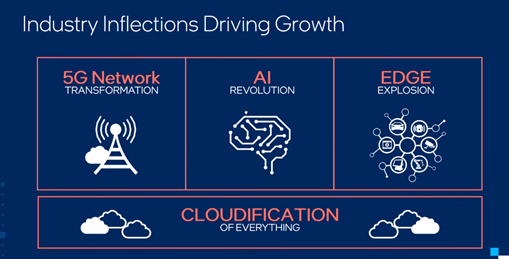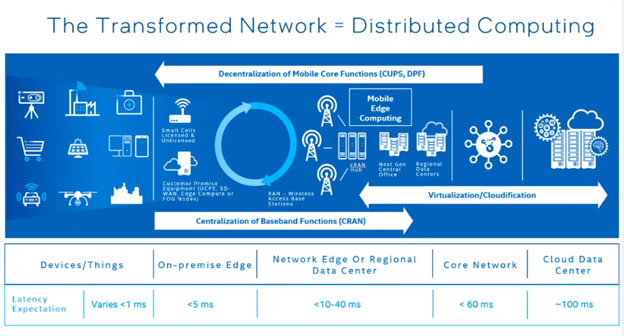
Cover image | Visual China
The development of 5G and the Internet of Things is leading to an explosive growth in data.
According to a report by IDC titled “Data Age 2025”, it is predicted that by 2025, the total global data volume for data analytics will increase by 50 times, reaching 5.2ZB. Among this data, three-quarters will be generated and computed outside of centralized data centers.
The explosion of data is increasing the demand for computing power, while both organizations and individuals are increasingly demanding real-time computing. All of this is giving rise to a brand new computing paradigm—edge computing.
For three consecutive years, edge computing has been recognized as one of the “Top 10 Strategic Technologies” by the globally renowned consulting firm Gartner, transforming the way millions of devices around the world process and transmit data.
Readers familiar with edge computing are likely familiar with the “octopus analogy”. As the animal closest to “edge computing”, the octopus’s brain serves as a central node, processing only about 40% of the information, mainly responsible for overall coordination; the remaining majority of information is independently processed by the octopus’s tentacles (equivalent to edge nodes).
This means that more than half of the octopus’s brain cells are distributed across its eight tentacles, which can use their “legs” to think and make decisions, solving problems on-site. This flexible and efficient information processing method has also contributed to the intellectual peak of this invertebrate.
Although humans cannot biologically simulate octopuses, with the development of communication technology, we increasingly need to achieve computing and decision-making at the “tentacle” edge.
To maximize the “superpowers” of the intelligent era, we also need the “tailwind” of infrastructure
“By 2025, 75% of data will be generated outside of data centers in factories, hospitals, retail stores, and urban edges.”
At the recently concluded Mobile World Congress in Barcelona (hereinafter referred to as MWC), Intel Vice President Dan Rodriguez made this prediction in his speech. By 2025, the proportion of data generated by enterprises processed outside of “traditional” centralized data centers or cloud storage will jump from 10% in 2018 to 75%.
With the rapid development of 5G communications, the scale of data is surging, and technologies such as wireless networks, cloud, edge, and artificial intelligence are showing a trend of integration, undoubtedly bringing new opportunities for the transformation of the digital world.
Cloud, 5G-driven connectivity, artificial intelligence, and smart edge are the “superpowers” of technology in the intelligent era, changing human society from various aspects. However, to maximize the potential of these “superpowers”, we need a “tailwind”—flexible, agile, and scalable infrastructure.

Historically, the maturity of new technologies from cloud computing to artificial intelligence has required the readiness of related infrastructure to truly achieve large-scale implementation and generate real value.
In the early 2000s, the basic premise for the maturity of cloud computing was the emergence of shared computing power and shared networks, with the advent of virtual machines, virtual networks, and early infrastructure being prerequisites for the widespread adoption of cloud computing; the third wave of artificial intelligence has also benefited from the significant reduction in the costs of data storage and transmission.
On this basis, the continuous maturity of GPUs has provided the necessary computing power support, improved algorithm usability, and reduced computing costs, allowing the world to enter the era of deep learning and making large-scale applications of natural language processing and computer vision recognition possible.
The maturity of 5G has brought a qualitative leap in data transmission technology and has given rise to new technological trends, making edge computing possible. The demands for computing scale and real-time performance have posed challenges to the communications industry, such as the rapid growth of data generation and the rapid expansion of cloud-scale computing, which correspondingly raises higher requirements for infrastructure: only with a robust network that provides reliable, low-latency communication in a flexible and scalable manner can it meet the current and future needs of AI-based edge services.
This also means that communication networks will evolve from fixed-function devices to virtualized cloud-native deployments, achieving enhanced dedicated network solutions in enterprises and enabling edge-to-cloud communication, thereby unleashing the full potential of the 5G hyper-connected world.
In the trend of edge computing + 5G, how to seize the opportunity?
Under the trend of 5G + edge computing, ultra-fast connectivity based on a strong network infrastructure becomes increasingly important, especially for mission-critical applications. At the recently concluded MWC, how to prepare for this transformation and seize the opportunity was one of the key topics of interest among major communication and technology vendors.
A sufficiently robust network and low-latency communication require powerful chips + solutions suitable for 5G wireless networks, and major tech giants are actively exploring this field. This year at MWC, the established chip manufacturer Intel presented its solutions, hoping to enhance the technological infrastructure to accelerate edge 5G wireless networks.
Dan Rodriguez stated in his speech, “(The communication revolution’s) next frontier is changing the access network, welcoming the era of virtualized radio access networks (vRAN) delivered through open ecosystems. This can bring cloud-like agility and automation capabilities, helping to optimize RAN performance and ultimately enhance the quality of user experience.”
This is both a trend of 5G + edge computing, where edge computing can be said to carry the dream of the Internet of Everything in the 5G era, with new data sources generating new insights, thereby creating new revenue streams; on the other hand, the development of communication technology and infrastructure has already met the demands of the (vRAN) era.
It is estimated that in the coming years, the global deployment of vRAN base stations will grow from hundreds to “tens of thousands”, ultimately reaching millions.
Although vRAN is still in its early stages, visionary tech companies have already recognized this demand and have increased investment in hardware, software reference architectures, and ecosystems.
Taking Intel as an example, its recently released vRAN solution provides cloud-like agility and automation capabilities, capable of optimizing RAN performance. Intel has also expanded the capabilities of its Agilex FPGA highly programmable chips by adding new FPGAs with integrated encryption acceleration features, ensuring support for MACSec in 5G applications, which adds another layer of security to vRAN.

Intel also hopes to empower this series of technological capabilities on its platform as the technological infrastructure, reducing development complexity, accelerating enterprise infrastructure deployment time, and enabling more communication companies to leverage the capabilities of Intel hardware and share the capabilities of edge computing.Currently, almost all commercial vRAN deployments run on Intel® technology, including telecom operators like Deutsche Telekom and Telefonica.
Infrastructure upgrades, a global wave of 5G wireless access network revolution begins
With technological infrastructure ready, the deployment projects for global 5G wireless access networks are gradually starting.
In the United States, one of the largest satellite broadcasting service providers, DISH, is collaborating with Intel to build the first cloud-native 5G network in the U.S.
DISH was established in the 1980s and provides television entertainment and communication technology to millions of customers through its satellite DISH TV and streaming SLING TV services. In the past, the relevant signal transmission and deployment mainly relied on hardware forms like antennas and RF front ends. Although this infrastructure is relatively mature and still important for 5G deployment, it is costly, time-consuming, and inflexible.
This collaboration with Intel has provided DISH with a comprehensive core infrastructure upgrade, making 5G deployment fast and convenient through radio access networks, reducing development costs, and preparing the technology for a data-driven 5G ecosystem. The DISH Wireless edge network is built around Intel’s Xeon Scalable processors, vRAN dedicated accelerator ACC100, and its FlexRAN software architecture.
DISH’s Chief Network Officer, Marc Rouanne, stated that they are using VMware virtualization software and Intel-based servers to “load and mix different types of cloud-native workloads”, including virtual routers, mobile edge computing applications, and containerized network functions for 5G core.
In addition to providing enterprise edge application solutions, Intel will also assist DISH in exploring future collaborations after 5G deployment, including edge data optimization and machine learning, as this long-standing communication company rides the wave of edge computing.
In India, the top telecom operator Reliance Jio has also recently announced a joint technological innovation development with Intel in the fields of 5G radio and wireless core, as well as collaboration in other related areas, including artificial intelligence, cloud, and edge computing.
This intention for cooperation actually began to take shape a year ago. Last year, Intel invested $250 million in this Indian super operator, stating that the two companies would jointly explore the possibilities of technological collaboration. At the end of last month, Intel finally announced a milestone in the cooperation between the two companies—joint innovation regarding Reliance Jio’s 5G radio access network (RAN).

Navin Shenoy, Executive Vice President and General Manager of Intel’s Data Platform Group, stated in an interview with Reuters:“This is the result of the partnership between the two companies. The potential for 5G in India will be enormous, and(Reliance Jio) is doing it in a non-traditional way.”
Reliance Jio has been exploring new possibilities for building 5G networks. Through collaboration with Intel, this operator is no longer primarily relying on traditional telecom-specific companies like Nokia and Ericsson for basic communication base station equipment, but turning to “software” infrastructure to provide more network services. The collaboration with Intel will assist Reliance Jio in exploring the vast market potential of 5G in India.
Domestically, China Mobile’s subsidiary, China Mobile IoT, is guided by the company’s “Big Connection” strategy, integrating edge computing, cloud computing, artificial intelligence, and 5G technologies to build and enhance the OneNET edge computing platform to accelerate intelligent innovation in manufacturing.
Around the OneNET edge computing platform, China Mobile IoT is not only creating intelligent solutions for various manufacturing production lines but is also seeking high-performance infrastructure to provide strong computing power and efficient visual reasoning capabilities. The MEC server deployed on this platform, VCAC-A, is a strong “core” needle equipped in collaboration with Intel aimed at visual reasoning capabilities.
The potential of every new technology relies on the maturity of its technological infrastructure. As Dan Rodriguez depicted at the end of his speech, “As 5G and edge computing work together to unleash their potential, artificial intelligence, cloud computing, and smart cities will become the norm: factory automation will flourish with Industry 4.0, and retail stores will redesign the shopping experience.
For consumers, cloud gaming, virtual reality, and augmented reality on mobile networks will become daily experiences.” As the performance of virtualized radio access networks gradually optimizes and deployment times shorten, the potential of 5G + edge computing will also be maximized, heralding an interconnected world.
Special Planning